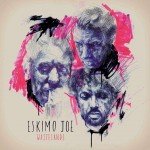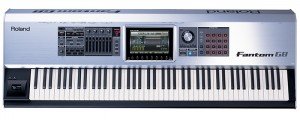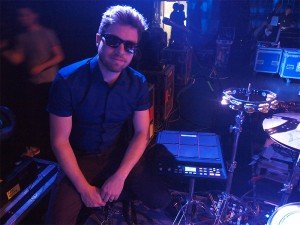In September 2013, Australian pop rockers Eskimo Joe released Wastelands, their sixth album and one which presents a significant change for the band both musically and commercially. Greg Phillips tracked down Eskimo Joe’s Stuart Macleod and Joel Quartermain backstage at The Forum Theatre prior to the Melbourne date of their Wastelands tour to discuss the creation of the album and how they are reproducing it live.
Contributed by Greg Phillips, Video Produced by James Phillips
Five albums into a stellar music career, the multiple ARIA award-winning trio Eskimo Joe threw caution to the wind and left the safety of a major record label to go totally independent. Their sixth album Wastelands, was funded by the generosity of fans through the Pozible website. Not only had the band amended the way they operated from a business perspective but it was also time for a change musically. With Wastelands, Eskimo Joe have taken an unexpected electro-pop route. It’s the sound of a band enjoying themselves, exploring tones and beats outside of their comfort zone, free of the shackles of record company constraints. Spontaneity was the theme rather than the completely mapped out studio experience they had been used to and the band could not be happier with the way it has all turned out.
“It’s worked out great,” says Stu Macleod enthusiastically. “It’s been one of the more positive recording experiences of our lives … of our career. The writing experience was quite difficult. As you get older, you get more stubborn and set in your ways. When you are trying to redefine the band and seek a new sound, there’s obviously going to be a lot of disagreements before you settle on something that works. I don’t think we really got any idea of how the album was going to sound until we got in the studio proper and pressed record. Once the producer was in the room, it took about 5 or 6 weeks and it all changed and evolved.”
 The producer the band settled on for this album was Burke Reid, best known for the quirky synth-pop albums he created with his own band Gerling. “I guess he revitalised us as creative thinkers,” Stu says of Burke’s approach in the studio. “He chucked a few things on their head, even down to the way we strummed the guitars. Instead of going down, up, down, up, he’d say start with the up stroke. After playing guitar for 20 years that just feels completely weird and wrong but it also makes the performance sound a little more naive and unpolished. So it was little tricks like that that took us out of our comfort zone.”
The producer the band settled on for this album was Burke Reid, best known for the quirky synth-pop albums he created with his own band Gerling. “I guess he revitalised us as creative thinkers,” Stu says of Burke’s approach in the studio. “He chucked a few things on their head, even down to the way we strummed the guitars. Instead of going down, up, down, up, he’d say start with the up stroke. After playing guitar for 20 years that just feels completely weird and wrong but it also makes the performance sound a little more naive and unpolished. So it was little tricks like that that took us out of our comfort zone.”
Recreating the new album live is still a work in progress for the band and is something they’re working hard at in rehearsals. “There’s way less guitar going on and there’s a lot of space in the music,” says Joel. “Everything that you are playing on stage is a little bit more important because the music is so sparse. It’s been a process of working out how to get the sounds that we have on the album, because Burke had a million guitar pedals in front of him and ran everything through that and distorted everything. We weren’t taking notes or photos of how this was being done, so we had to rely on our ears once we got into the rehearsal room as to how to work it out.”
A lot of the sounds on Wastelands were created with vintage synths such as the Roland Jupiter 4 and other rare beasts that you can’t actually run on stage due to their outdated technology. The need to replicate those sounds as truly as possible led to a search for emulators via forums and online synth communities. However, much of the responsibility for the synth sounds on stage has been handed to additional band member Tony Bourke who is working overtime on keyboards. “He has four hands,” laughs Stu.
But it wasn’t all about vintage gear in the production of Wastelands. The guys are huge fans of newer workstations like the Roland Fantom G8 and that unit came in handy too.
 “Going back to Black Fingernails, Red Wine it wouldn’t have been the G8, it was the X8, but that is all over that record,” recalls Joel. “You can hear that keyboard (X8) heaps on that record. We went for the more vintage synths with this one but there are certain sounds like the Theramin. That’s a classic, such a good sound. So we used it (the G8) for stuff like that. Also for using MIDI stuff, we’d use that because it is such a nice keyboard to play, so much nicer than a little MIDI keyboard. It actually feels like a piano.”
“Going back to Black Fingernails, Red Wine it wouldn’t have been the G8, it was the X8, but that is all over that record,” recalls Joel. “You can hear that keyboard (X8) heaps on that record. We went for the more vintage synths with this one but there are certain sounds like the Theramin. That’s a classic, such a good sound. So we used it (the G8) for stuff like that. Also for using MIDI stuff, we’d use that because it is such a nice keyboard to play, so much nicer than a little MIDI keyboard. It actually feels like a piano.”
“A lot of the sounds on the G8 we have used and then Burke would run it through a pedal,” Stu adds. “He would then turn a million patches on and distort it and run it through a bunch of preamps and compressors. Before you knew it, it was its own unique sound.”
 With so much going on sonically and only four guys on stage, there had to be an element of triggering involved. Stu explains how that was achieved. “We’re running an SPD, the SX, the new updated version of the SPD, which is great. The old one was very reliable but had the old memory card technology. With the SX now, you just put it on a USB stick, throw it in the back and you’re done. Plus the laptop application, where you can just drag and drop onto the onscreen graphics, is really handy. It’s great for organising the songs and set lists. It’s probably one of the more user-friendly products we use,” Stu says.
With so much going on sonically and only four guys on stage, there had to be an element of triggering involved. Stu explains how that was achieved. “We’re running an SPD, the SX, the new updated version of the SPD, which is great. The old one was very reliable but had the old memory card technology. With the SX now, you just put it on a USB stick, throw it in the back and you’re done. Plus the laptop application, where you can just drag and drop onto the onscreen graphics, is really handy. It’s great for organising the songs and set lists. It’s probably one of the more user-friendly products we use,” Stu says.
The pedal boards of the Eskimo Joe guitarists for this tour have been tailored to suit the music too. Not as many guitar parts, so not as many pedals. One pedal Stu has traditionally included in his rig though is the Boss RV-5 digital reverb. “I’ve been using the RV5 for years now,” he says. “I like the versatility. It has a bunch of different reverb settings. Instead of having just one pedal that’s a one trick pony, you can do a bunch of different reverbs which is good.”
“One Boss product which has been really handy to use recently,” adds Joel, “is the RC-300 looper pedal. We find that it’s a really cool and creative tool. We just did an acoustic stripped back tour and we relied on that pedal heaps. We put a lot of loops onto it, drum loops and stuff like that. Also when we are doing radio performances of our current single, Got What You Need, it all triggers off a drum loop. So we take that little pedal to whatever radio station we are playing at and di it and it sounds great. It’s a very reliable pedal and user friendly as well.”
Joel also used the RC-300 on a recent side project with Karnivool’s bass player Jon Stockman. “We had the bass player from Karnivool, Jon Stockman, myself and a visual artist working,” explains Joel.” Jon had about 15 pedals beside him and I had a mic going into the loop pedal. The mic and auxiliary inputs are great. We basically ran the whole show off that looper pedal. We’d build up a song in the course of twenty minutes until it was vibing off its head. Then we’d erase that and start again. The recording quality is top notch, so I couldn’t recommend that more.”
While we’re on the subject of Boss pedals, the guys also take the opportunity to praise the TU-2 tuner pedal. “They have been a bit of an industry standard for us for many years … for as long as I can remember. I’ve never had a problem with them, which is a rare thing to say about pedals,” says Stu. Joel agrees. “That’s your desert island pedal. You’ve gotta have one. They’re really reliable.” Eskimo Joe generally use three tunings with their music; standard tuning, tuning everything down a half step, or down a full step. So completely all in D, E flat or E and the TU2 achieves all of that for them without any hassle. “It’s the most user-friendly tuner out there,” adds Joel.
With Wastelands now released, the Eskimo Joe guys have created a brave new world of music with endless possibilities. “Yeah, I think we have pretty much given ourselves carte blanche to do anything after this record,” says Stu. “Who knows what the future is going to hold”
www.eskimojoe.net




